Hardware Kits For Fralin Necks
Complete your Fralin Neck with a Complete Hardware Kit!


Imagine this heartbreaking scenario: you just purchased a Bridge pickup for your guitar. You’re excited to throw it in and rock out, so you get it installed and plug it in. The pickup sounds great on its own, but when you combine the Bridge with the Middle pickup, it sounds like crap! It seems thin, hollow, and weak. What happened? What went wrong?
Your Bridge pickup is out of phase with the rest of your pickups. Now, you have to take it out, send it back to us, and pay for shipping again to get it back in phase with your other pickups. Not cool. If you had known about pickup polarity beforehand, you would have avoided this issue altogether.
Fear not! We are here to educate you – we want to make you an expert on Pickup Polarity so you can avoid these pesky problems in the future. So, if that sounds like something you want to avoid, read on!
When you play an electric guitar, your guitar pickups create a voltage that get sent to the amplifier and then to the speaker. The signal you create is like a sine wave – and the wave can either “push” or “pull” on the speaker.
In reality, there are a few things that contribute to the overall polarity of your guitar’s pickup: Magnet Polarity and Coil Direction (or Wind Direction). A magnet can only be either North or South, and the Coil Direction can either be clockwise or counter-clockwise (don’t worry, we’ll explain these further).
The ideal situation is to have your pickup In-Phase and Hum-Cancelling with other pickups. You’ve probably heard the term “Reverse Wound / Reverse Polarity” (RWRP) – well, that’s what we’re talking about. We’re talking about an In-Phase and Hum-Cancelling set or pair of pickups. There are four important considerations when making a pickup. Let’s break them down:
Now that we’ve discussed what polarity is, let’s break down how you can find your own pickup’s polarity so you can avoid mixing out-of-phase pickups in the future. This may seem a little daunting, but with the right tools and our handy guide, you’ll be able to identify your pickup’s polarity in no time!
Learn this essential skill – if you ever plan on replacing a single pickup in a guitar, this skill is invaluable to learn.
Magnet Polarity is super important – unlike coil direction, you cannot easily reverse it if things are out of phase. At the shop, we can magnetize a pickup any way, easily – it’s much harder to do after the pickup has been made, depending on the style.
Your pickups either have North or South aimed at your strings. If you have a compass, it’s easy to do: hold the compass on top of your pickup, on its side. This will allow you to observe which way the compass pulls.
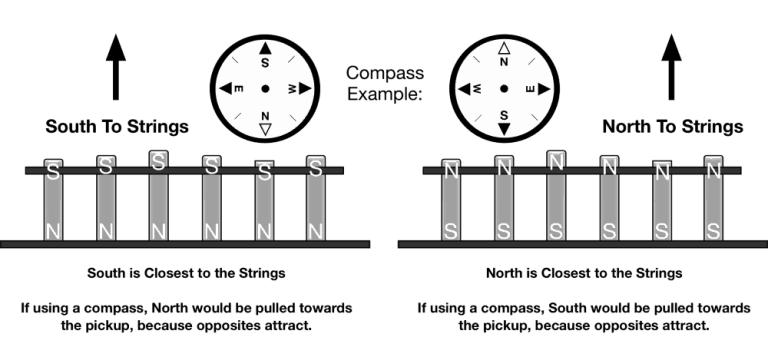
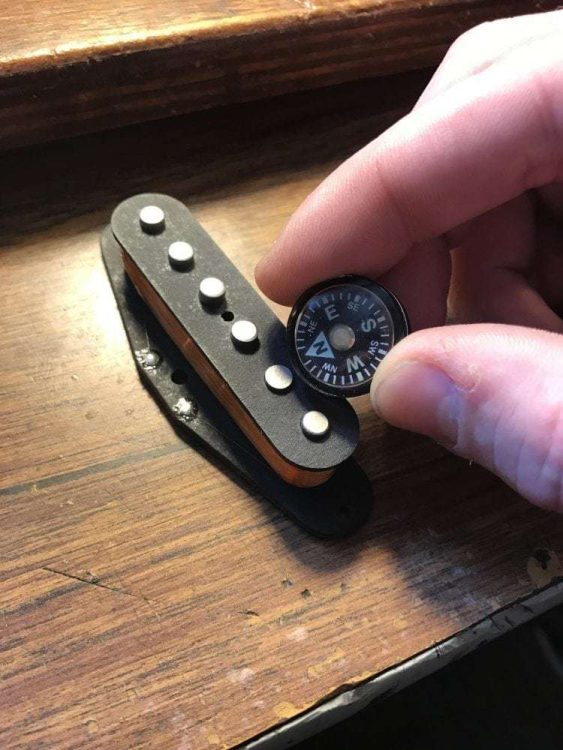
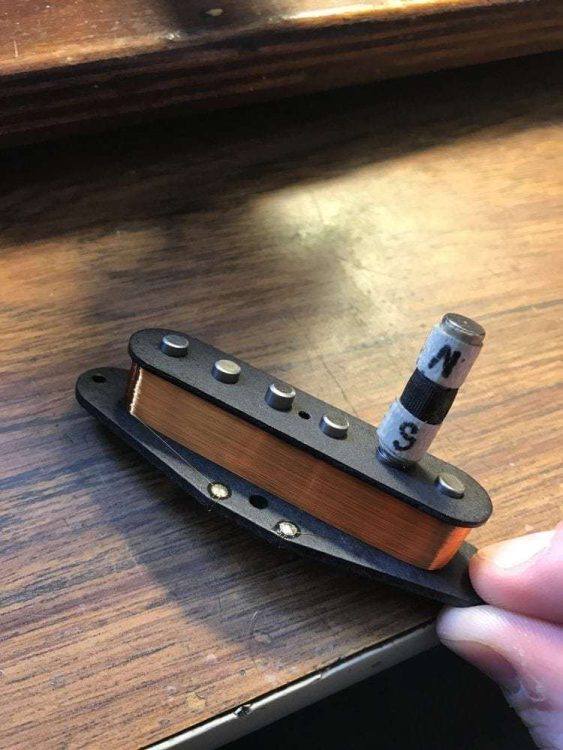
On single coil pickups, coil direction is an essential part of pickup polarity. Learn how to identify it here.
When we wind a pickup, we wind it one of two ways – “clockwise from ground to hot”, or “counter-clockwise from ground to hot”. Here’s what that looks like:
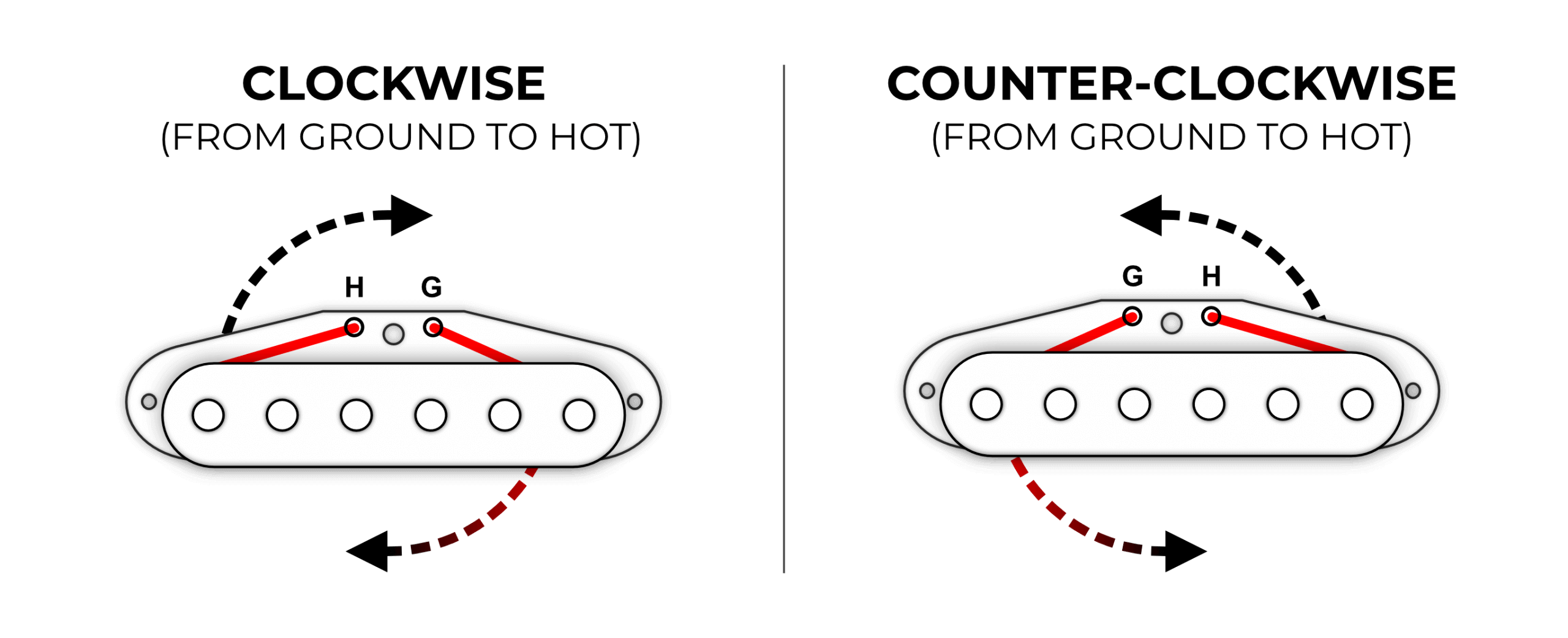
Illustrated above is where the coil starts and ends. As you can see, the coil starts on the left on Bottom To Winder, and on the right with a Top to Winder pickup.
The Start of the coil is always shown by our Black lead, and the last turn is denoted by our White lead. For a real-world example, see below:
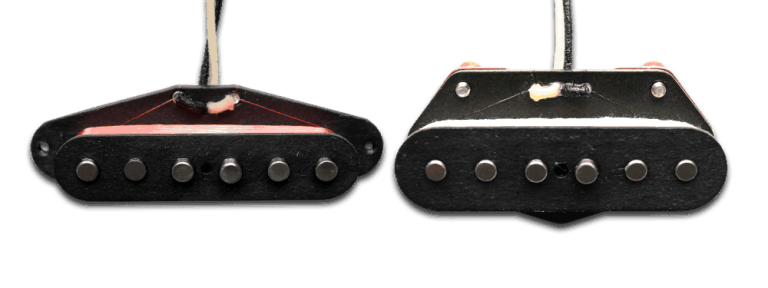
In the above image, the Strat Pickup on the left was wound counter-clockwise from Ground to Hot. The Tele Bridge on the right has a clockwise coil direction, from Ground to Hot.
The best thing to do here is to pull your pickup out and look at it. Use the above image to reference what direction your coil was wound.
Send us a picture of the pickup out of the guitar. If we can see the leads, we can denote the coil direction
Check with your manufacturer, or do a quick search on the internet for your exact model. This is not always the best case because there is not a lot of consistency throughout the industry.
Let’s put all of the concepts of Pickup Polarity together with a common example: Stratocaster wiring. With Stratocaster pickups, positions 2 & 4 of the 5-way switch are both in-phase and hum-cancelling.
When the Bridge and the Middle pickup combine, their coil directions and their magnetic orientations reverse. This cancels hum and keeps pickups in phase:
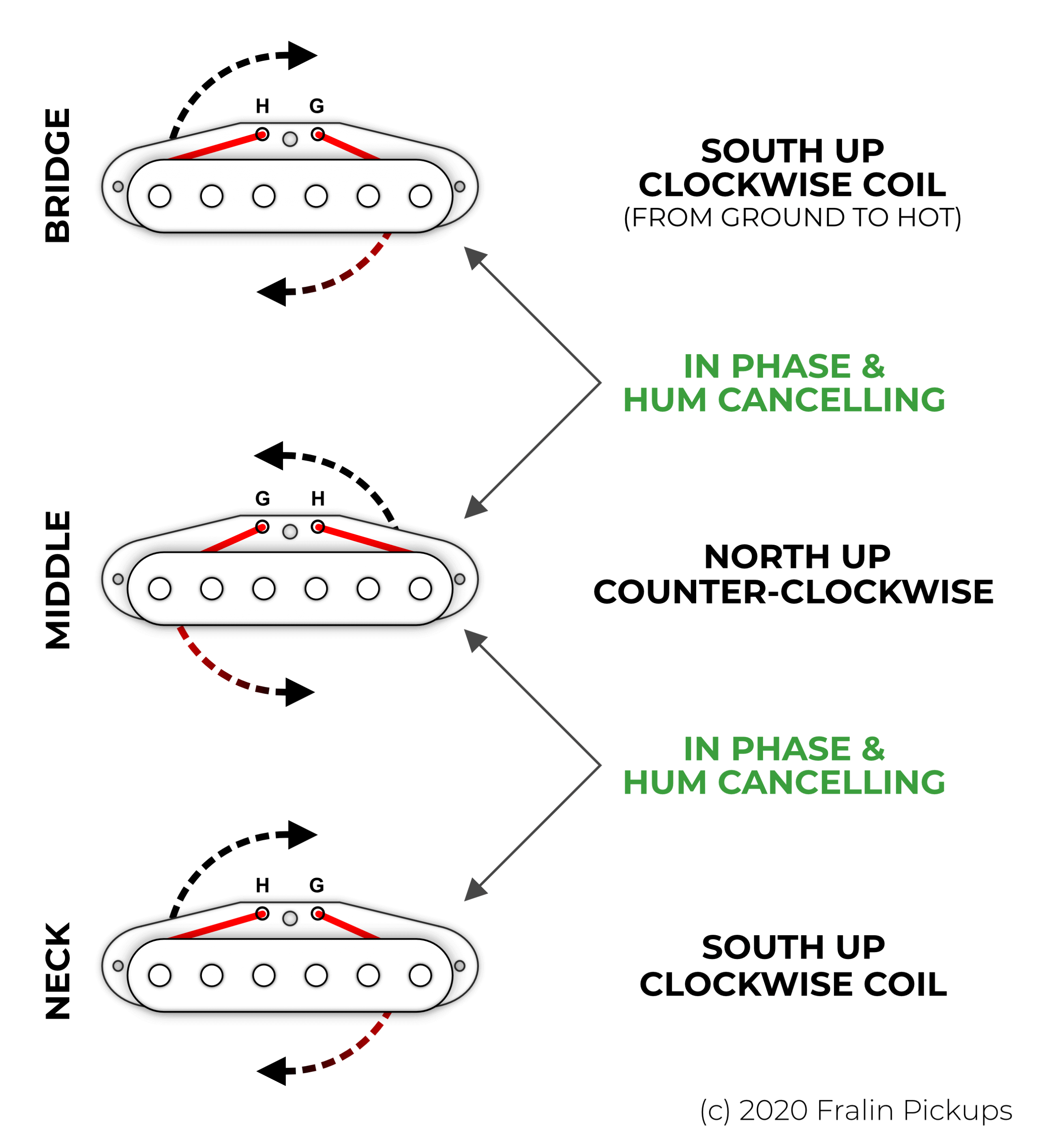
The same applies for virtually any instrument that uses Single Coil pickups: Telecasters, Jazz Basses, Mustangs, and Jazzmasters…the list goes on.
If your pickups are out of phase, you might be able to fix it yourself. You can try to reverse the coil direction, for example. However, reversing only one “attribute” of a pickup can cause some unintended side-effects. Here are some potential problems, and how to diagnose them:
Hum-cancelling pickups are a little easier to identify, as one part of the puzzle is already given to us. A Humbucker (this can be our hum-canceling P-90’s, Hum-Cancelling Jazzmasters, Split Blades, etc.) has both magnetic directions already. So, you don’t need to worry about Magnetic Orientation. What you do need to know is Coil Direction. This is really easy – just order your pickup with Multiple Leads, or, your can reverse your coil direction by flipping the leads:

As you can see, Polarity can be a little confusing. We hope this helps break it down. If you have any questions, give us a call! We’ll do our best to help.
80 Comments For This Post
Want to chime in to the conversation? Please do so! Please respect others.
I have a1983 kramer pioneer carerra bass. It has pj pickups 2v1t 1-3way and a second i believe was another 3 way. I sent it in for repair because a switch went out, and recieved it back with a 2 way in its place. I can’t find any literature about the original wiring to see if it was 2 3-way switches, how they were wired or what they were for. I need to replace all of it.
I have lindy Fralin humbucker that sounds out of phase with my other pickup (seymour duncan pearly gates) can I reverse the wires on the duncan to correct this or do I have to send the fralin pickup to you to reverse polarity….
Hi,
in case of single coil RWRP middle stratocaster pickup . Is the copper wire’s winding direction is phisically opponent around the bobbin against the other two standard single coils, or just a ground and hot outputs (another words the output wires “colour”) are swaped ?
Thanks !
Surely the compas points towards the pole, so if the compass if N towrds the magnet end then the magnet end is north. meaning that the N side on a compass is actually S ,so that it is atracted towards the north and points north?
Hi Lindy and team
i bought a fralin blues special neck and fralin stock tele bridge separately. when i installed them in my tele. i have phasing issue. rookie as i am. I did not know about this.
what will be your advice or any fix for this problem that i have? I am in Japan so your pickups are quote difficult to find here. specially from where i am at.
This explanation regarding pickup magnetic fields and opposites attract was EXTREEMLY helpful thank you so much.
I have a a Tele with two Wide Range Humbuckers. I want to install a traditional single coil in the neck position. How do I determine the correct wind of the new single coil so it will be compatible with the WRH? Will the 2 lead option cover this scenario?
A precision pickup has two separate coils, each with a different polarity and winding direction , what is the correct way to wire them together and which magnetic polarity coil is used for the E and A strings, this is in a PJ configuration the J pickup has a polarity north against the strings? Thanks
Hi Lindy,
So what’s the deal with basses? Specifically PJ basses? I have a Fender P in a PJ configuration but the J pick up is wrong for many reasons, which I won’t bother with here. But I want a vintage sound, rather than the offered PJ set here in your shop, plus I love the P pickup I already have. But P pickups are split singles, so does all of the above still apply? And how do you even tell if your pickups are out of phase?
Hey Fred,
That’s a good question about P/J basses. The deal here is that you usually have a Hum-Cancelling P-Bass pickup and a Single-Coil J-Bass pickup. If your pickups are out-of-phase, you can quickly remedy this by reversing the White and Black leads on the P-Bass pickup only.
You can tell when your pickups are out of phase when you run both pickups simultaneously. If you experience a thin, hollow, nasally tone, you know your pickups are out of phase with each other.
Hello, I have a 1953/54 Fender champion lap steel pickup for a lead position in a telecaster project. This old pickup is North up polarity. I need a rythm telecaster pickup but I am not sure what polarity is needeed ? Thanks a lot ! Alex
I have a 1953 Epiphone Zenith archtop. I want to have a pickup – either single coil or humbucker – attached to the end of the fretboard. I’m not thinking about having a volume control or anything else attached to a pickguard (which I don’t have). I want the pickup connected to an endpin jack and control volume and tone with a pre-amp. Looking for an old DeArmond sound, or something similar to the old gold foil pickups that used to be on Harmony guitars. Any thoughts about what’s available that could come close to what I want?
You write: “Pickup polarity is the combination of Magnetic Direction and Coil Direction. Your Pickup can have either North or South pointing towards the strings, and the coil could be Clockwise or Counterclockwise (more on this later). Both the magnets and coil options equate to a 25% chance that your pickup will be in phase if you take a guess when ordering.”
Polarity in this context should refer just to the magnet – nothing else. Using it to refer to the combination gets too confusing – you then have to explain that the “polarity” in “RWRP” just means the magnets’ (relative) polarity. Since RWRP is so widely used, reserve polarity for how it is used there, for the magnet(s) only. Other manufacturers do that. So their material (and other published information) explains things in ways that contradict yours.
And there is not a 25% chance that a pickup will be in-phase. Firstly a SINGLE pickup is neither in-phase NOR out-of-phase. Phase only relates to two pickups – and they are either in-phase or out-of-phase with EACH OTHER. So any pickup has a 50% chance of being in-phase (or out-of-phase) with any other pickup.
Engineers will still understand the nuances without you confusing the average player.
Hey AH,
These are good points here, and we’d like to clarify our argument:
1.) Lindy refers to Polarity as a combination of the Magnetic Polarity (he says orientation, but we understand that magnets have ‘poles’) as well as wind direction. He mainly thinks of polarity as a combination of the two. We understand where you are coming from! This could be a simpler way of describing it, or understanding it.
2.) The 25% in this scenario refers to being both in-phase AND hum-cancelling, which is the best-case scenario. When you factor in two pickups, each with a magnetic orientation (polarity) and wind direction, at it’s simplest form, yes – there’s a 25% chance that you’ll achieve both hum-cancelling and being in phase.
Hope that clears up our position!
What if I were to go with HS, the single coil being RWRP and the humbucker being 4-Conductor, could I have Neck/Neck+Split Humbucker/Humbucker and still have the middle position be hum canceling?
Hi! I have a 2 pickup jazzmaster with a Gibson burstbucker in bridge and the middle seems out of phase. Do I need a new pickup to get middle in phase or is it wired wrong? Thanks
Hey Gary,
Thanks for your question.
Your pickups are out of phase with each other. If you have multiple leads on your Burstbucker, you can resolve this. You’ll need to reverse white and ground to change the coil direction. I’m not 100% familar with Gibson Burstbucker Wiring, however. Please note if you have Gibson Braided lead, you cannot reverse the humbucker. You may be able to reverse the leads of your neck pickup, but, you risk having ‘hot’ magnets.
What about a situation in which the guitar has two four wire humbuckers connected to a coil splitting DPDT switch?
The configuration is one volume, one tone, and a three way pickup selector (neck on, both on, bridge on). I bought this single cutaway solid body guitar because I love how it plays, but it has been “modded” with high output hum buckers and the coil split switch.
The pickups have their screw sides facing opposite directions (neck side screws face neck, bridge side screws face bridge). In all switch positions, the pickups sound weak and thin like they are out of phase. Could it be that the hot wires need to be reversed on both pickups at the DPDT coil split switch, or could the direction the pickups face cause the problem (currently in opposite directions)?
Hi, thank you for all the info! I find this article as well as so many others on this site amazing, so I appreciate it. This article cleared up a lot of questions for me about phase and polarity, but also made me question humbuckers even more than I was before.
Correct me if I’m wrong, but a humbucker is usually essentially two single coils that are in phase and hum-cancelling, so they are “Reverse Wound / Reverse Polarity” (RWRP), right?
So how is this achieved if humbuckers only have one magnet? And how does this come into play when combining two humbuckers together? Are there any articles that go into detail about this that you can point me to?
Thank you very much!
Hey Nathan,
You’re correct in your thinking that a Humbucker is two single coils that are in phase and hum-cancelling. You’re able to achieve two magnet orientation by using one bar magnet. One side of the Bar magnet (let’s say the Screw Side is North, the back of the magnet would magnetize the Slug Side South).
I hope that clears it up!
Hi,
I have an American Tele with twisted Tele in neck and custom shop vintage in the bridge. I would like to put a P92 in neck position… will that work? do I need to change cap? polarity? Love the sound of P92
Mike
Hey Mike,
Thanks for your question. All you would need to do is order your P-92 with 2-Conductor With Shield lead. This will allow you to reverse the phase if you need to.
Hello,
I am currently doing a Mustang build with a Seymour Duncan JB Jr in the bridge. I was looking at the Fralin Mustang Vintage pickup for the neck but after reading the polarity article have some concerns. What would you advise? Thanks!
Hey Joe,
Polarity should be no issue with these if you order your pickup with “3-Wire” configuration. The 3 Wire configuration allows you to reverse the phase. When you order 3-Wire Configuration, you’ll get a White, Black, and a Blue. The Blue is ‘chassis ground’, and should remain grounded. White is normally hot, and Black is normally ground. However, if you’re out of phase in the middle position, you can reverse this (white goes to ground, black is hot) and you’ll be in phase.
Tyler
Hello
What if we have HSS ??
Hey Cyrus,
The only issue there is coil direction from your humbucker since humbuckers have both magnetic directions. That being said, if you have a humbucker where you can reverse the entire coil direction (2-Conductor with Shield, 3-Conductor With Shield, 4-Conductor with Shield), you’ll be good no matter what you choose to put in the Neck and Middle. Keep in mind that Gibson-lead humbuckers cannot be reversed.
Hope that helps!
Tyler
Bit of a unique case here. I’m building a steel-string Kora, with 2 x sets of 8 strings 25mm apart from each other.
If I use one pickup in the middle of these two sets of strings, one set of strings will be picked up by the South/Clockwise side of the pickup, and the other will be picked up on North/anticlockwise side. Any idea if this would work at all, and if so would it sound terrible?
Thanks,
Chris
Hey Chris,
This situation will work fine. It’s the same thing as a Strat or a Tele when in positions 2 (or 2 & 4 on a Strat). As long as the “hots” go to the output, and “blacks” go to ground, you’ll have traditional Parallel Wiring, and hum-canceling.
Hope that helps.
Tyler
Hi. huge fan of many fralin pu,s. my current problem :
HSH strat. fralin p90 humcancel pair in bridge and neck, middle is vintage split rail SDuncan. all sound great in their solo 1,3,5 positions. Super thin in 2,4. can i reverse the wires in the SD vintage rail to get an in-phase sound on 2,4 switch position?
Interesting article, thank you. What about the “rule of thumb”? It indicates that pointing the thumb to north direction and doing the “hitchhiker” gesture the other four fingers would indicate the direction of the magnetic field and so the direction of the current inducted into the wire. Following that I’d think that the ideal winding direction of a north pickup would be counterclockwise and clockwise on a pickup pointing south. Do you consider that or doesn’t that make a difference?
Hey Ralf,
Yes, it is true that the “right-hand rule” is how a signal generates in the pickup. However, it doesn’t matter which coil direction or magnetic direction is combined – it still generates a signal either way. Also, in order to have a hum-canceling pair, you need one of each.
Great question!
Tyler